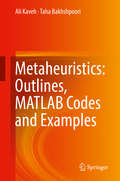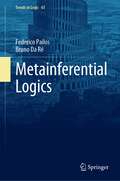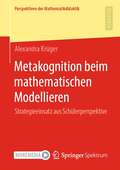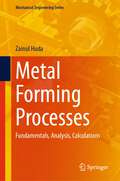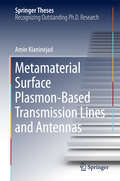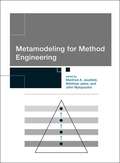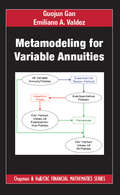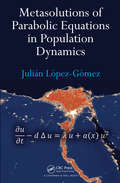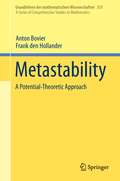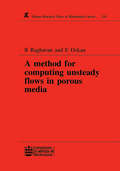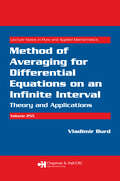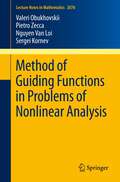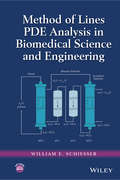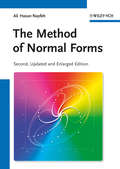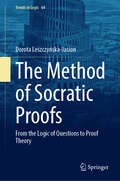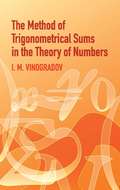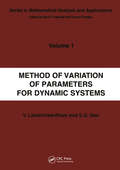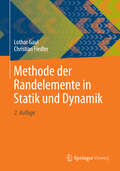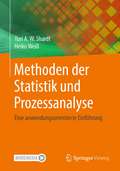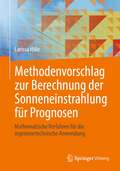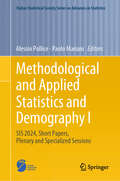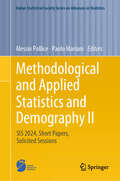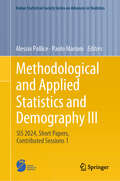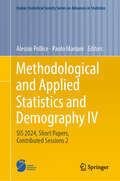- Table View
- List View
Metaheuristics: Outlines, MATLAB Codes and Examples
by Ali Kaveh Taha BakhshpooriThe book presents eight well-known and often used algorithms besides nine newly developed algorithms by the first author and his students in a practical implementation framework. Matlab codes and some benchmark structural optimization problems are provided. The aim is to provide an efficient context for experienced researchers or readers not familiar with theory, applications and computational developments of the considered metaheuristics. The information will also be of interest to readers interested in application of metaheuristics for hard optimization, comparing conceptually different metaheuristics and designing new metaheuristics.
Metainferential Logics (Trends in Logic #61)
by Federico Pailos Bruno Da RéThis book is the first to present a comprehensive investigation of the technical features of the metainferential logics developed in the last years, with their most relevant results and applications. It provides some new paths to define and investigate metainferential logics and offers a thorough study of the semantics and the proof-theories of this new and exciting variety of families of logics.This volume examines the hierarchies of metainferential logics and gives a general and systematic theory of them, and of the truth theories based on these logics. This book puts forward the prospects for truth-theories based on the metainferential logics of the TS/ST hierarchy and argues for its promise noting that each of these logics can be safely expanded with a transparent truth predicate. It also goes onto to explore new developments in three fields related to logics – namely metainferential logics built by means of the Weak Kleene schema and combining them with logics defined through the Strong Kleene schema, proof-theoretic presentations, and those with a with a global or an absolutely global validity standard, instead of a local one. This book is of interest to scholars in formal logic.
Metakognition beim mathematischen Modellieren: Strategieeinsatz aus Schülerperspektive (Perspektiven der Mathematikdidaktik)
by Alexandra KrügerIn der Arbeit werden die Sichtweisen von Schülerinnen und Schülern auf den Einsatz metakognitiver Strategien in der Gruppenarbeit beim mathematischen Modellieren analysiert. Im Fokus der Analysen stehen die Auslöser für den Einsatz metakognitiver Strategien und deren Auswirkungen aus Schülerperspektive. Dabei konnten Schülertypen metakognitiver Strategien rekonstruiert werden, die die Sichtweisen und Einstellungen der Schülerinnen und Schüler auf den Einsatz metakognitiver Strategien widerspiegeln. Auf Grundlage dieser Schülertypen werden Hinweise für geeignete Lehrerinterventionen zur Förderung des metakognitiven Strategieeinsatzes entwickelt.
Metal Forming Processes: Fundamentals, Analysis, Calculations (Mechanical Engineering Series)
by Zainul HudaThis unique textbook features fundamentals and analyses of metal forming processes supported by 200 worked numerical examples. It provides rigorous detail on the three all-important groups of metal-forming processes: bulk-metal forming, sheet-metal forming, and sheet-bulk-metal forming. Theory of metal forming is presented by discussing deformation behavior, plasticity, and formability with a thorough mathematical analyses and calculations. The mechanics of sheet metal forming is also covered by including principal strain increments in uniaxial loading as well as plane stress deformation. There are 125 diagrammatic illustrations/real-life photographs that have been labelled properly to enhance the understanding of readers. Among the salient features of the book is the inclusion of industrially-oriented projects, covering both technological and business considerations. The key solutions connected to these projects are presented with the aid of mathematical analysis and process flow diagrams. The book includes 100 multiple-choice questions (MCQs) with their answers and those for selected problems facilitating self-directed learning.
Metamaterial Surface Plasmon-Based Transmission Lines and Antennas (Springer Theses)
by Amin KianinejadThis thesis proposes a reliable and repeatable method for implementing Spoof Surface Plasmon (SSP) modes in the design of various circuit components. It also presents the first equivalent circuit model for plasmonic structures, which serves as an insightful guide to designing SSP-based circuits. Today, electronic circuits and systems are developing rapidly and becoming an indispensable part of our daily life; however the issue of compactness in integrated circuits remains a formidable challenge. Recently, the Spoof Surface Plasmon (SSP) modes have been proposed as a novel platform for highly compact electronic circuits. Despite extensive research efforts in this area, there is still an urgent need for a systematic design method for plasmonic circuits. In this thesis, different SSP-based transmission lines, antenna feeding networks and antennas are designed and experimentally evaluated. With their high field confinement, the SSPs do not suffer from the compactness limitations of traditional circuits and are capable of providing an alternative platform for the future generation of electronic circuits and electromagnetic systems.
Metamodeling for Method Engineering
by Manfred Jeusfeld Matthias Jarke John MylopoulosThis text is a guide to the foundations of method engineering, a developing field concerned with the definition of techniques for designing software systems. The approach is based on metamodeling, the construction of a model about a collection of other models. The book applies the metamodeling approach in five case studies, each describing a solution to a problem in a specific domain. Suitable for classroom use, the book is also useful as a reference for practitioners. The book first presents the theoretical basis of metamodeling for method engineering, discussing information modeling, the potential of metamodeling for software systems development, and the introduction of the metamodeling tool ConceptBase. The second, and larger, portion of the book reports on applications of the metamodeling approach to method engineering. These detailed case studies range from telecommunication service specification, hypermedia design, and data warehousing to cooperative requirements engineering, chemical device modeling, and design of new abstraction principles of modeling languages. Although these chapters can stand alone as case studies, they also relate to the earlier theoretical chapters. The metamodeling approach described in the book is based on the Telos metamodeling language implemented by the ConceptBase system. An accompanying CD-ROM contains the ConceptBase system and a large collection of Telos metamodels discussed in the text. The CD-ROM enables readers to start directly with method engineering, from small method chunks up to complete method definitions. The complete definition of Ed Yourdon's structured analysis method is included as an instructional example.
Metamodeling for Variable Annuities (Chapman and Hall/CRC Financial Mathematics Series)
by Guojun Gan Emiliano A. ValdezThis book is devoted to the mathematical methods of metamodeling that can be used to speed up the valuation of large portfolios of variable annuities. It is suitable for advanced undergraduate students, graduate students, and practitioners. It is the goal of this book to describe the computational problems and present the metamodeling approaches in a way that can be accessible to advanced undergraduate students and practitioners. To that end, the book will not only describe the theory of these mathematical approaches, but also present the implementations.
Metasolutions of Parabolic Equations in Population Dynamics
by Julián López-GómezMetasolutions of Parabolic Equations in Population Dynamics explores the dynamics of a generalized prototype of semilinear parabolic logistic problem. Highlighting the author's advanced work in the field, it covers the latest developments in the theory of nonlinear parabolic problems.The book reveals how to mathematically determine if a species maintains, dwindles, or increases under certain circumstances. It explains how to predict the time evolution of species inhabiting regions governed by either logistic growth or exponential growth. The book studies the possibility that the species grows according to the Malthus law while it simultaneously inherits a limited growth in other regions.The first part of the book introduces large solutions and metasolutions in the context of population dynamics. In a self-contained way, the second part analyzes a series of very sharp optimal uniqueness results found by the author and his colleagues. The last part reinforces the evidence that metasolutions are also categorical imperatives to describe the dynamics of huge classes of spatially heterogeneous semilinear parabolic problems. Each chapter presents the mathematical formulation of the problem, the most important mathematical results available, and proofs of theorems where relevant.
Metastability
by Anton Bovier Frank Den HollanderThis monograph provides a concise presentation of a mathematical approach to metastability, a wide-spread phenomenon in the dynamics of non-linear systems - physical, chemical, biological or economic - subject to the action of temporal random forces typically referred to as noise, based on potential theory of reversible Markov processes. The authors shed new light on the metastability phenomenon as a sequence of visits of the path of the process to different metastable sets, and focuses on the precise analysis of the respective hitting probabilities and hitting times of these sets. The theory is illustrated with many examples, ranging from finite-state Markov chains, finite-dimensional diffusions and stochastic partial differential equations, via mean-field dynamics with and without disorder, to stochastic spin-flip and particle-hop dynamics and probabilistic cellular automata, unveiling the common universal features of these systems with respect to their metastable behaviour. The monograph will serve both as comprehensive introduction and as reference for graduate students and researchers interested in metastability.
A Method for Computing Unsteady Flows in Porous Media (Chapman And Hall/crc Research Notes In Mathematics Ser. #318)
by R RaghavanSelf-contained and concise, this Research Note provides a basis to study unsteady flow in saturated porous media. It provides for the development of algorithms that examine three-dimensional flows subject to complicated boundary conditions that are a natural consequence of flow in geological systems. A new way to understand the flow in porous media is presented. The authors pay attention to computational considerations, and options for developing codes are addressed. The note consists of five chapters: the first is introductory; the second and third are devoted to showing how one arrives at the solutions of interest; the fourth chapter presents various reformulations to aid computations and presents a few illustrative examples; the fifth chapter is a natural progression of the first four chapters to more complicated visualizations of flow in porous media.
Method of Averaging for Differential Equations on an Infinite Interval: Theory and Applications (Lecture Notes in Pure and Applied Mathematics)
by Vladimir BurdIn recent years, mathematicians have detailed simpler proofs of known theorems, have identified new applications of the method of averaging, and have obtained many new results of these applications. Encompassing these novel aspects, Method of Averaging of the Infinite Interval: Theory and Applications rigorously explains the modern theory of the me
Method of Guiding Functions in Problems of Nonlinear Analysis
by Valeri Obukhovskii Sergei Kornev Nguyen Van Loi Pietro ZeccaThis book offers a self-contained introduction to the theory of guiding functions methods, which can be used to study the existence of periodic solutions and their bifurcations in ordinary differential equations, differential inclusions and in control theory. It starts with the basic concepts of nonlinear and multivalued analysis, describes the classical aspects of the method of guiding functions, and then presents recent findings only available in the research literature. It describes essential applications in control theory, the theory of bifurcations, and physics, making it a valuable resource not only for "pure" mathematicians, but also for students and researchers working in applied mathematics, the engineering sciences and physics.
Method of Lines PDE Analysis in Biomedical Science and Engineering
by William E. SchiesserPresents the methodology and applications of ODE and PDE models within biomedical science and engineering With an emphasis on the method of lines (MOL) for partial differential equation (PDE) numerical integration, Method of Lines PDE Analysis in Biomedical Science and Engineering demonstrates the use of numerical methods for the computer solution of PDEs as applied to biomedical science and engineering (BMSE). Written by a well-known researcher in the field, the book provides an introduction to basic numerical methods for initial/boundary value PDEs before moving on to specific BMSE applications of PDEs. Featuring a straightforward approach, the book's chapters follow a consistent and comprehensive format. First, each chapter begins by presenting the model as an ordinary differential equation (ODE)/PDE system, including the initial and boundary conditions. Next, the programming of the model equations is introduced through a series of R routines that primarily implement MOL for PDEs. Subsequently, the resulting numerical and graphical solution is discussed and interpreted with respect to the model equations. Finally, each chapter concludes with a review of the numerical algorithm performance, general observations and results, and possible extensions of the model. Method of Lines PDE Analysis in Biomedical Science and Engineering also includes: Examples of MOL analysis of PDEs, including BMSE applications in wave front resolution in chromatography, VEGF angiogenesis, thermographic tumor location, blood-tissue transport, two fluid and membrane mass transfer, artificial liver support system, cross diffusion epidemiology, oncolytic virotherapy, tumor cell density in glioblastomas, and variable grids Discussions on the use of R software, which facilitates immediate solutions to differential equation problems without having to first learn the basic concepts of numerical analysis for PDEs and the programming of PDE algorithms A companion website that provides source code for the R routines Method of Lines PDE Analysis in Biomedical Science and Engineering is an introductory reference for researchers, scientists, clinicians, medical researchers, mathematicians, statisticians, chemical engineers, epidemiologists, and pharmacokineticists as well as anyone interested in clinical applications and the interpretation of experimental data with differential equation models. The book is also an ideal textbook for graduate-level courses in applied mathematics, BMSE, biology, biophysics, biochemistry, medicine, and engineering.
The Method of Moments in Electromagnetics
by Walton C. GibsonThe Method of Moments in Electromagnetics, Third Edition details the numerical solution of electromagnetic integral equations via the Method of Moments (MoM). Previous editions focused on the solution of radiation and scattering problems involving conducting, dielectric, and composite objects. This new edition adds a significant amount of material on new, state-of-the art compressive techniques. Included are new chapters on the Adaptive Cross Approximation (ACA) and Multi-Level Adaptive Cross Approximation (MLACA), advanced algorithms that permit a direct solution of the MoM linear system via LU decomposition in compressed form. Significant attention is paid to parallel software implementation of these methods on traditional central processing units (CPUs) as well as new, high performance graphics processing units (GPUs). Existing material on the Fast Multipole Method (FMM) and Multi-Level Fast Multipole Algorithm (MLFMA) is also updated, blending in elements of the ACA algorithm to further reduce their memory demands. The Method of Moments in Electromagnetics is intended for students, researchers, and industry experts working in the area of computational electromagnetics (CEM) and the MoM. Providing a bridge between theory and software implementation, the book incorporates significant background material, while presenting practical, nuts-and-bolts implementation details. It first derives a generalized set of surface integral equations used to treat electromagnetic radiation and scattering problems, for objects comprising conducting and dielectric regions. Subsequent chapters apply these integral equations for progressively more difficult problems such as thin wires, bodies of revolution, and two- and three-dimensional bodies. Radiation and scattering problems of many different types are considered, with numerical results compared against analytical theory as well as measurements.
The Method of Normal Forms
by Ali H. NayfehIn this introductory treatment Ali Nayfeh presents different concepts from dynamical systems theory and nonlinear dynamics in a rigorous yet plan way. He systematically introduces models and techniques and states the relevant ranges of validity and applicability. The reader is provided with a clear operational framework for consciously use rather than focused on the underlying mathematical apparatus. The exposition is largely by means of examples, dealt with up to their final outcome. For most of the examples, the results obtained with the method of normal forms are equivalent to those obtained with other perturbation methods, such as the method of multiple scales and the method of averaging. The previous edition had a remarkable success by researchers from all over the world working in the area of nonlinear dynamics and their applications in engineering. Additions to this new edition concern major topics of current interest. In particular, the author added three new chapters dedicated to Maps, Bifurcations of Continuous Systems, and Retarded Systems. In particular the latter has become of major importance in several applications, both in mechanics and in different areas. Accessible to engineers and applied scientist involved with nonlinear dynamics and their applications in a wide variety of fields. It is assumed that readers have a knowledge of basic calculus as well as the elementary properties of ordinary-differential equations.
The Method of Socratic Proofs: From the Logic of Questions to Proof Theory (Trends in Logic #64)
by Dorota Leszczyńska-JasionThis book contains a systematic and formal attempt to model solutions to problems such as: Is it possible to prove a question? Is it possible to prove something by the use of questions? Do the existing paradigms in the logic of questions allow one to combine questions and proofs? What are the results in this field? In developing answers, the book focuses on the applications of the method of Socratic proofs, and goes beyond that. It starts out with an overview of the leading paradigms, issues, problems and ready solutions in the logic of questions, and places Inferential Erotetic Logic and the method of Socratic proofs against a wider background. It then introduces these two methods in more detail and explains how they can be used for classical logic, intuitionistic propositional logic and for basic modal logics. Next, the book deals with issues specific to the field of the logic of questions, introducing the tools of Minimal Erotetic Semantics (MiES). The final chapters describe the translations between proof systems: from a Socratic transformation, derived in an erotetic calculus, into a sequent system.
The Method of Trigonometrical Sums in the Theory of Numbers (Dover Books on Mathematics)
by I. M. VinogradovSince the 1930s, the analytic theory of numbers has been transformed by the influence of I. M. Vinogradov, and this text for upper-level undergraduates and graduate students testifies to its author's ingenuity and to the effectiveness of his methods. Starting with a discussion of general lemmas, it advances to an investigation of Waring's problem, including explorations of singular series, the contribution of the basic intervals, and an estimate for G(n). Further topics include approximation by the fractional parts of the values of a polynomial, estimates for Weyl sums, the asymptotic formula in Waring's problem, the distribution of the fractional parts of the values of a polynomial, estimates for the simplest trigonometrical sums with primes, and Goldbach's problem. 1954 edition.
Method of Variation of Parameters for Dynamic Systems
by V. LakshmikanthamMethod of Variation of Parameters for Dynamic Systems presents a systematic and unified theory of the development of the theory of the method of variation of parameters, its unification with Lyapunov's method and typical applications of these methods. No other attempt has been made to bring all the available literature into one volume. This book is a clear exposition of this important topic in control theory, which is not covered by any other text. Such an exposition finally enables the comparison and contrast of the theory and the applications, thus facilitating further development in this fascinating field.
Methode der Randelemente in Statik und Dynamik
by Lothar Gaul Christian FiedlerDie gut eingeführte Methode der Randelemente baut auf den Grundlagen der Kontinuumsmechnik auf. In diesem Buch wird sie für die Elastodynamik schwingender Strukturen und für die Elastostatik formuliert. Die mathematischen und ingenieurwissenschaftlichen Grundlagen werden bereitgestellt; einfache Beispiele erleichtern das Verständnis. Das Buch liegt nun in einer 2. korrigierten Auflage vor. Es richtet sich an Studierende, Ingenieure und Naturwissenschaftler, die sich Kenntnisse der Randelementmethode erarbeiten wollen.
Methoden der Statistik und Prozessanalyse: Eine anwendungsorientierte Einführung
by Yuri Shardt Heiko WeißDieses Buch konzentriert sich auf die Anwendung von modernen Methoden derStatistik zur Modellierung und Analyse von Prozessmodellen der Verfahrenstechnik.Beispiele für moderne Methoden sind Matrixansätze, im Gegensatz zumanuellen Berechnungen, sowie das Konzept orthogonaler Basen. Diese Ansätzeermöglichen eine computergestützte Analyse von Versuchsplänen.Zunächst werden die wichtigsten Aspekte und Methoden der Statistik und Prozessanalysevorgestellt. Auf dieserGrundlage werden anschließend komplexere Methoden für die Anwendungerarbeitet. Hierbei legen die Autoren großen Wert auf eine kurze, jedoch umfassendeund konsistente Darstellung.Zur Erleichterung der Implementierung werden detaillierte Vorgehensweisen fürdie relevanten Konzepte vorgestellt und anhand geeigneter Beispiele vorgestellt. Die Beispiele sind so gewählt, dass sie mit vorhandenen Softwarewerkzeugen (Matlab, Excel) nachgebildet werden können. Für diesen Zweck werden Excel-Vorlagen undMATLAB-Programme bereitgestellt. Ein ausführliches deutsch-englisches Glossar ist ebenfalls enthalten.
Methodenvorschlag zur Berechnung der Sonneneinstrahlung für Prognosen: Mathematische Verfahren für die ingenieurtechnische Anwendung
by Larissa HilleIn diesem Buch werden mathematische Verfahren zur Lösung folgender Aufgaben vorgestellt:(Absatz)- Berechnen der Sonnenposition;(Absatz)- Berechnen der Leistung, die ein Lichtstrahl auf seinem Weg durch die Atmosphäre durch Absorption und Streuung verliert;(Absatz)- Berechnen der Strahlenverteilung in einer Wolkenschicht;(Absatz)- Berechnen diffuser Strahlung, die aus einer Atmosphärenschicht bei einer vorgegebenen Verteilung der gestreuten Strahlung zu einer ebenen Oberfläche (Solarmodul) oder zur Seitenfläche eines stehenden Kegelstumpfs (Windkraftanlagenturm) gestreut wird und diese Fläche in bestimmten Winkeln trifft.
Methodological and Applied Statistics and Demography I: SIS 2024, Short Papers, Plenary and Specialized Sessions (Italian Statistical Society Series on Advances in Statistics)
by Alessio Pollice Paolo MarianiThis book of peer-reviewed short papers on methodological and applied statistics and demography is the first of four volumes from the 52nd Scientific Meeting of the Italian Statistical Society (SIS 2024), held in Bari, Italy, on June 17-20, 2024. It features invited contributions presented in the Plenary and Specialized Sessions. The volumes address a large number of topics and applications of current interest. The topics covered include, but are not limited to, statistical theory and methods, sampling theory, Bayesian statistics, statistical modeling, computational statistics, classification, data analysis, gender statistics and applied statistics. The applications reflect new analyses in a wide variety of fields, including demography, psychometrics, education, business, economics, finance, law, and other social sciences and humanities, epidemiology, the life and health sciences as well as the environmental and natural sciences and engineering. This variety also demonstrates the important role of statistical science in addressing the societal and environmental challenges of sustainable development. One of the aims of the Italian Statistical Society (SIS) is to promote scientific activities for the development of statistical sciences. Its biennial international Scientific Meeting represents the Society’s largest event which brings together national and international researchers and professionals to exchange ideas and discuss recent advances and developments in theoretical and applied statistics.
Methodological and Applied Statistics and Demography II: SIS 2024, Short Papers, Solicited Sessions (Italian Statistical Society Series on Advances in Statistics)
by Paolo Mariani Alessio PolliceThis book of peer-reviewed short papers on methodological and applied statistics and demography is the second of four volumes from the 52nd Scientific Meeting of the Italian Statistical Society (SIS 2024), held in Bari, Italy, on June 17-20, 2024. It features invited contributions presented in the Solicited Sessions. The volumes address a large number of topics and applications of current interest. The topics covered include, but are not limited to, statistical theory and methods, sampling theory, Bayesian statistics, statistical modeling, computational statistics, classification, data analysis, gender statistics and applied statistics. The applications reflect new analyses in a wide variety of fields, including demography, psychometrics, education, business, economics, finance, law, and other social sciences and humanities, epidemiology, the life and health sciences as well as the environmental and natural sciences and engineering. This variety also demonstrates the important role of statistical science in addressing the societal and environmental challenges of sustainable development. One of the aims of the Italian Statistical Society (SIS) is to promote scientific activities for the development of statistical sciences. Its biennial international Scientific Meeting represents the Society’s largest event which brings together national and international researchers and professionals to exchange ideas and discuss recent advances and developments in theoretical and applied statistics.
Methodological and Applied Statistics and Demography III: SIS 2024, Short Papers, Contributed Sessions 1 (Italian Statistical Society Series on Advances in Statistics)
by Alessio Pollice Paolo MarianiThis book of peer-reviewed short papers on methodological and applied statistics and demography is the third of four volumes from the 52nd Scientific Meeting of the Italian Statistical Society (SIS 2024), held in Bari, Italy, on June 17-20, 2024. It features the first part of the contributions presented in the Contributed Sessions. The volumes address a large number of topics and applications of current interest. The topics covered include, but are not limited to, statistical theory and methods, sampling theory, Bayesian statistics, statistical modeling, computational statistics, classification, data analysis, gender statistics and applied statistics. The applications reflect new analyses in a wide variety of fields, including demography, psychometrics, education, business, economics, finance, law, and other social sciences and humanities, epidemiology, the life and health sciences as well as the environmental and natural sciences and engineering. This variety also demonstrates the important role of statistical science in addressing the societal and environmental challenges of sustainable development. One of the aims of the Italian Statistical Society (SIS) is to promote scientific activities for the development of statistical sciences. Its biennial international Scientific Meeting represents the Society’s largest event which brings together national and international researchers and professionals to exchange ideas and discuss recent advances and developments in theoretical and applied statistics.
Methodological and Applied Statistics and Demography IV: SIS 2024, Short Papers, Contributed Sessions 2 (Italian Statistical Society Series on Advances in Statistics)
by Alessio Pollice Paolo MarianiThis book of peer-reviewed short papers on methodological and applied statistics and demography is the fourth of four volumes from the 52nd Scientific Meeting of the Italian Statistical Society (SIS 2024), held in Bari, Italy, on June 17-20, 2024. It features the second part of the contributions presented in the Contributed Sessions. The volumes address a large number of topics and applications of current interest. The topics covered include, but are not limited to, statistical theory and methods, sampling theory, Bayesian statistics, statistical modeling, computational statistics, classification, data analysis, gender statistics and applied statistics. The applications reflect new analyses in a wide variety of fields, including demography, psychometrics, education, business, economics, finance, law, and other social sciences and humanities, epidemiology, the life and health sciences as well as the environmental and natural sciences and engineering. This variety also demonstrates the important role of statistical science in addressing the societal and environmental challenges of sustainable development. One of the aims of the Italian Statistical Society (SIS) is to promote scientific activities for the development of statistical sciences. Its biennial international Scientific Meeting represents the Society’s largest event which brings together national and international researchers and professionals to exchange ideas and discuss recent advances and developments in theoretical and applied statistics.
